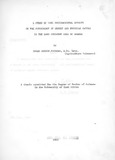| dc.description.abstract | It is hypothesised that Bos taurus breeds of dairy cattle are subjected to stress, either directly or indirectly, by the environment of the Lake Crescent region of Uganda. The response to this stress is examined by observing its effect on some blood constituents.
The examination of the data produced the following results:
(a) The definition of the usual values for some blood constituents of Jersey and Friesian cows in the Lake Crescent region.
(b) The haemoglobin and packed cell volume levels of the Jersey animal at 10.6 gms % and 31.6% respectively were lower than published results for known temperature conditions. The corresponding
Friesian results, 12.1 gms % and 34.6%, were in better agreement, though still on.the low side. The values for the total erythrocyte count of both Jersey and Friesian animals were in good agreement with published results from England.
The total leucocyte counts of the Jersey and Friesian animals were in agreement with some published results from England, but above others. On examining the differential leucocyte count, it was noted that the lymphocyte count of 6.423 thou/ral for the Jerseys and 4.456 thou/ml for the Friesians'was higher than the published figures for known temperature conditions,
while the neutrophil count was lower for both the Jersey (1.928 thou/ml) and Friesian (1.892 thou/ml) animals. With both breeds the eosinophil count agreed with the published results. From these findings, it was concluded that a breed difference existed between the Jersey and Friesian animals for some of the blood factors.
(c) The various blood factors all appeared to have a reasonably normal distribution, though a 3kew to the left was noted in most cases, except for the packed cell volume and total erythrocyte count which both had a slight skew to the right.
The daily variation for the various blood parameters was calculated and 95% confidence limits of the variation presented for an individual observation and the means of a series of observation.
(d) The blood picture of Jersey animals probably changes with age.
(e) The origin of the animal, whether from a tropical or temperate environment, has no apparent effect on the erythrocyte picture. With the leucocyte picture however, there was a considerable effect of origin. A general increase in all aspects of the leucocyte picture was noted for the cows recently imported from England, as compared to those bred locally.
(f) The main effect of climate and of milk production wa3 on the haemoglobin and packed cell volume results. Maximum and minimum
temperatures and milk production seemed to be exerting the main effect on these blood factors, with sun hours having a lesser effect on haemoglobin levels. Multiple linear regression equations are given, significant at greater than the 1% level, for these relationships. When there were high maximum and low minimum temperatures, the haemoglobin levels were high. At these times the milk production was low, this possibly being due to high temperatures causing a decrease in the metabolic processes of milk production to ensure the cows had adequate reserves to withstand stress.
The effect of the climate and milk production on the leucocyte picture appeared from the results to be minimal.
However, there may have been an effect, and this might have been obscured by a high infection rate of disease organisms.
(g) There was shown to exist an interaction between pregnancy and lactation, acting on the haemoglobin values, the packed cell volume results, and the total neutrophil counts. In these interactions
there was little difference between the lactating and non- lactating animals during pregnancy but a large difference was - noted in the non-pregnant condition. The lactating animals had lower haemoglobin and packed cell volume results, but higher neutrophil counts than the non-lactating animals.
The eosinophil count showed a main effect of pregnancy, and
no interaction with lactation. This count increased during the early stages of pregnancy, returning to normal levels during the latter part.
(h) The changes in the blood factors recorded for the Danish Friesian in-calf heifers (KDF) on introduction to the environment of the Lake Crescent region were different from those noted for the Danish Friesian calves (EDF). These variations have been described.
Future investigations into the production records of the two groups may indicate if these different responses of the blood factors are due to an increased adaptability on the part of the in-calf heifers as compared to the calves, or vice-versa.
(i) The results of the KDF heifers and EDF calves showed considerable differences from the results obtained for the Kabanyolo cows (KKF) which had been bred locally. This seemed to indicate that, as in the case of the Jersey animals, the new environment was causing changes in the blood picture of the newly arrived cattle.
(j) The measurement of stress via the blood picture, and the- association of milk production and the blood picture are discussed. | en_US |



